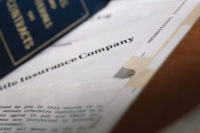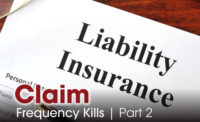Should I Make A Claim On My Liability Insurance?

Deciding when and how to report a claim or a potential claim under a business liability policy is a challenge most firms do not have a lot of experience with. In fact, most owners, based on their past track record, think they will never have a liability claim made against them. However, the proper reporting of claims and even potential claims is an important part of being able to collect under a liability insurance policy.
After five straight years of improved claims results, due largely to the valuable work of the IICRC and RIA in educating contractors, there is an up-tick in liability claims being made against restoration contractors in 2009.
I expect this adverse liability loss development trend to continue. In the face of increasing liability losses it is now more important than ever to be prepared to identify potential liability loss situations early in their development, and report them to your insurance company in a timely manner.
Cleaning and restoration contractors are just starting to experience the fallout of universal mold and bacteria loss exclusions in the insurance policies that their customers purchase and in their own business insurance policies.
The good news for insurance buyers is, so far, claims adjustors apparently have not actually read the new mold and bacteria “related” loss exclusions within the context of the developing case law on the subject. Virtually all of the developing case law in the state courts favors the insurance companies in denying losses involving mold and bacteria.
Because the claims adjustors have been following custom and practice and not adhering to the language in the new exclusions to the letter, they have apparently been paying losses that are technically no longer covered by the insurance policies of either the property owner or contractor.
That seems to be changing as claims that are “related to” mold and bacteria, which were paid as water damage losses in the past, are being denied today. Some part of denied property claims will logically gravitate towards liability losses for contractors.
The introduction of universal mold and bacteria exclusions in property owner’s insurance policies makes it much more likely that property owners will experience insurance coverage gaps for water related claims in the future. Without proper insurance, the property owner will be forced to look for any available deep pocket to help them pay for their uninsured loss.
We are starting to see this scenario play out more and more as the claims adjustors apparently are starting to read the mold and bacteria exclusions in their property insurance policies and are denying claims that have mold or bacteria in any way or in any sequence “related to” them.
Nobody knows what the words “related to” might mean in a common form of the exclusion, but a backed-up sewer definitely involves Category 3 water and, therefore, would be “related to” bacteria. And once a loss has an element of the “M” or “B” word involved with it, the door is wide open for an informed claims adjuster to deny the entire loss in many property and liability insurance policy forms sold today.
The good news for restoration contractors is that insurance is available to cover a wide spectrum of potential liability losses at relatively low cost. Restoration contractors today pay less for customized insurance packages with coverage for mold, bacteria, asbestos, lead and professional liability coverage than a remodeling contractor pays for a policy that excludes losses from all of these sources. This is a great time to buy high-quality insurance in the restoration business.
But no customized restoration liability insurance policies will do the contractor any good if claims and potential claims are not reported to the insurance company in a timely manner.

Fully disclosing all potential claims against the firm is especially important when switching insurance companies. Failure to do so exposes the applicant to the possibility of denial of a loss by the insurance company that has been replaced because their policy will not be in effect when an actual claim becomes known, while at the same time opening the door for the new insurance company to deny a loss from completed operations on the basis of the contractor failing to disclose a potential claim in the insurance application.
This is a common problem associated with switching liability insurance companies, because it is sometimes difficult to determine with certainty when a liability claim is going to be incurred.
The only way to keep from essentially voiding out your insurance for completed operations when changing liability insurance companies is to fully disclose potential liability claims to both the incumbent and replacement insurance companies before the change of insurance companies is made.
Unless a contractor fully discloses all suspected potential claims in the insurance applications, the new insurance company has a inherent cost advantage over the incumbent insurance company because the door is wide open for the new insurance company to deny losses from prior acts over the failure of the contractor to disclose potential new claims in the application for insurance.
The whole issue of full disclosure of potential losses in the insurance application is less critical if you are renewing with the same insurance company.
All liability insurance policies contain specific instructions on how to report a claim. Failure to follow these specific instructions in a timely manner can make it difficult to collect under the policy. However, in spite of these clear instructions on where and how to report a claim, it is common for insurance buyers to not follow the instructions in the policy. In a large-loss situation, insurance companies will put the claim under the microscope looking for reasons not to pay it.
Coverage problems as a result of poor claims reporting practices are easy to avoid; simply follow the instructions in the insurance policy. Your insurance agent can help with this, but remember, many policies require that the notice loss come from the insurance buyer, not the person who sold the policy.
As a general rule, there is little downside to reporting claims or potential claims to an insurance company, but there is a big downside to the late reporting of a claim resulting from a situation at a job that would indicate a liability claim could be forthcoming. The most common liability claim scenario for a restoration contractor is this: a property owner becomes disillusioned with the contractors work and asks the contractor to discontinue operations.
In these cases it is usually alleged that the contractor’s work was faulty, but it could also be related to the owner just being told they do not have insurance coverage on the loss and the owner is simply trying to cut expense corners.
The owner does not pay the contractor for the work performed, the contractor puts a lien on the owner’s property and the owner sues the contractor for the “damages” the contractor allegedly caused. To make things attractive to a trial lawyer it is common to throw in some “Johnny cannot learn in school anymore” allegations in addition to the “I need to get my house fixed” costs.
If this situation evolves over time and the contractor has changed insurance companies during this period, there is a big question which insurance company may be on the hook for the loss. Two well-intentioned claims adjusters could easily develop rational reasons why their employer should have nothing to do with this loss. The only way to avoid a coverage gap is to have both insurance companies fully aware of the potential loss situation before a switch is made.

Loss-free firms generally pay 20 percent less for liability insurance than a firm with moderate loss frequency. Paying 20 percent more for liability insurance is unpleasant but is not a company buster.
The problem with frequent claims on a General Liability or Environmental policy is that claims frequency, even small claims, can lead to the complete unavailability of insurance at any price, which will put a firm out of business a lot faster than an actual loss payout will. Claims frequency is the real issue: one claim for $400,000 will have much less effect on the cost and availability of future insurance than five losses totaling $20,000.
So there is a balancing act to perform between reporting claims and potential claims, minimizing the cost of insurance and maintaining the availability of insurance in future years. The best way to perform the balancing act is not to get into potential liability situations at all, plus carrying high enough deductibles so that affordable claims do not reach the historical liability insurance loss reports.
But dealing with claims within deductible amounts is tricky if a liability claim expands beyond the deductible. Any firm can find themselves with a potential liability claim, an unhappy customer, a subcontractor getting injured on a jobsite, or damage to someone’s property. When this occurs the insurance buyer needs to look to the actual insurance policy for instructions on how to report a claim or a potential claim; simply leaving a voicemail with the insurance agent will not suffice for proper notice to the insurance company.

You must see to it that we are notified as soon as practicable of an incident that may result in a “claim”. To the extent possible, notice should include:
- How, when and where the incident “took place, and when the insured first became aware of the incident; and
- The names and addresses of any injured persons and witnesses;
- The nature and location of any injury, “loss” and/or “damages” arising out of the incident.
Things speed up on the timing of notice when that incident claim becomes a “Claim” under the policy:
If a “claim” is made or “suit” is brought against any insured, you must:
- Immediately record the specifics of the “claim” or “suit” and the date received; and
- Notify us as soon as practicable and you must see to it that we receive written notice of the “claim” or “suit” as soon as practicable.
- You and any other involved insured must: Immediately send us copies of any demands, notices, summonses or legal papers received in connection with a “claim” or “suit”;
- Authorize us to obtain records and other information
Practical Advice on Claims Reporting
- Implement protocols that enable the management to become aware of potential liability loss scenarios at jobs.
- Notify your insurance companies of potential liability claims as soon as they become known.
- On renewals of current liability insurance policies and when changing insurance companies, pay very close attention to the notice requirements for potential claims in the insurance application.
- If you are ever notified of a liability situation, immediately follow all of the instruction in the policy to report it to your insurance company.
Looking for a reprint of this article?
From high-res PDFs to custom plaques, order your copy today!






